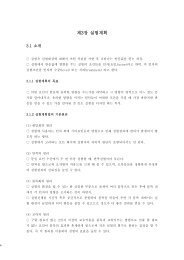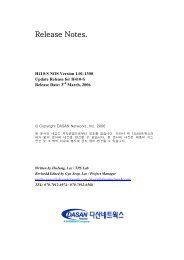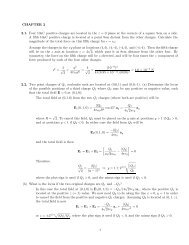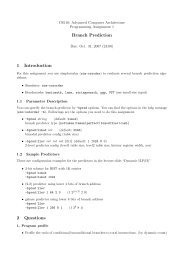Example: Viterbi algorithm
Example: Viterbi algorithm
Example: Viterbi algorithm
Create successful ePaper yourself
Turn your PDF publications into a flip-book with our unique Google optimized e-Paper software.
ing and subtracting the soft decision values. Second, 3 and -4 can be scaled to approximately 1and -1 respectively. As mentioned in the derivation of local distance 1 , constant scaling can beignored in determining the maxima and the minima. Finally, note that there are only two uniquemetric magnitudes, 1 and 7. Therefore, to compute the branch metric, you only need to do 1 add,1 subtract, and 2 negation.Once the branch metrics are calculated, the state metrics and the best incoming paths for each destinationstates can be determined. The state metrics at time 0 are initialized to 0 except for state00, which takes on the value of 100. This value is arbitrarily chosen and is large enough so that theother initial states cannot contribute to the best path. This basically forces the traceback to convergeon state 00 at time 0.The state metrics are updated in two steps. First, for each of the two incoming paths, the correspondingbranch metric is added to the state metric of the originating state. The two sums arecompared and the larger one is stored as the new state metric and the corresponding path is storedas the best path. Take state 10 at time instance 2 for example (Figure 4). The two paths coming into this state originates from states 00 and 01 (Figure 3). Looking at the second trellis, we see thatstate 00 has a value of 93 and state 01 has a value of 1. The branch metric of the top path (connectingstate 00 at time 1 and state 10 at time 2) is 1. The branch metric of the bottom path (betweenstates 01 and 10) is -1. The top path gives a sum of 93 + 1 = 94 and the bottom path give a sumof 1+ (–1)= 0. As a result, 94 is stored as the state metric for state 10 at time 2 and the top pathis stored as the best path in the transition buffer.The transition buffer stores the best incoming path for each state. For a radix 2 trellis, only 1 bit isneeded to indicate the chosen path. A value of 0 indicates that the top incoming path of the givenstate is chosen as the best path whereas a value of 1 indicates that the bottom path is chosen. Thetransition bits for our example is illustrated in Figure 4 in the third trellis.Traceback begins after completing the metric update of the last symbol in the frame. For frame byframe <strong>Viterbi</strong> decoding, all that is needed by the traceback <strong>algorithm</strong> are the state transitions. Thestarting state is state 00. For sliding window decoding, the starting state is the state with the largeststate metric. In our example, the starting state for both types of decoding is 00 since it has thelargest state metric, 158. Looking at the state transition for state 00, we see that the bottom path isoptimal (state transition = 1 implies bottom path). Two things now happen. First, the transition bit,1, is sent to the decoder output. Second, the originating state, state 01, of this optimal path isdetermined. This process is repeated until time 2, which corresponds to the first input bit transmitted.The decoded output is shown in Figure 4 in the last row. Notice that the order with which thedecoded output is generated is reversed, i.e. decoded output = 10101101 whereas the sample inputpattern is 10110101. Additional code need to be added to reverse the ordering of the decoded outputto exactly reconstruct the sample input.



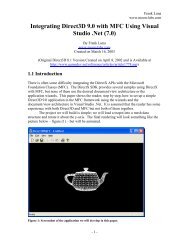



![Finale 2006 - [autumn leaves.MUS]](https://img.yumpu.com/46046993/1/184x260/finale-2006-autumn-leavesmus.jpg?quality=85)
